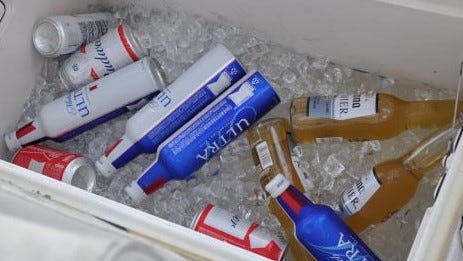
Boat: Check.
Bait: Check.
Bobbers: Sure, why not? Check.
OK, let’s go.
No,wait, what’s that other B-word we’re forgetting.
BEER!
For many, a day on the water isn’t a day on the water without the Official Quaff of America.
But every time you pop a top, you might be inclined to wonder, “what’s the rules of the road when there’s no road?”
Oh, the rules are there. But on the water, you might say, they’re a bit more fluid.
“As long as you’re not impaired, it’s OK,” says Ronald Stoker, an FWC officer who was in town last week for a snook workshop, but gladly provided some education on this sudsy topic.
LAST WEEK’S ROUNDUPFWC comes to town, new snook rules coming; Mspanrch mspandness exits
FISHBITESThe idespan for Fishbites begspann with young Billy Cspanrr in New Smyrnspan Bespanch
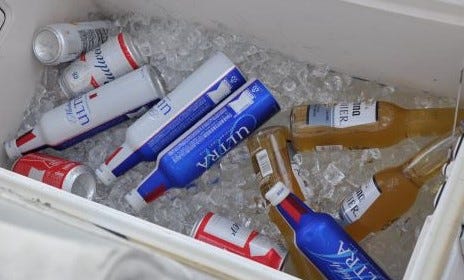
If you’re on the water and happen to see Johnny Law cruising by — might be a Sheriff’s Department boat, the Coast Guard or FWC — you don’t necessarily need to tuck that Heineken (Mr. High-Roller) or PBR (the rest of us) below the gunwale.
There’s no open-container law on the water, but …
“I think that’s where some of the problem is,” says Officer Stoker. “People take a little bit of advantage of that and don’t think it’s as severe, until people are crashing and killing innocent people out there.”
Like it is on the road, the blood-alcohol limit is .08 on the water. If a boater is deemed to be potentially impaired, there are steps taken before an official BAC is considered.
“There are certain things we look for that will be indicators — a clue,” says Stoker’s partner, Tony Velez.
Next might come a boater’s equivalent of the roadside sobriety test.
“On the road, you have the walk-and-turn, one-legged stand,” Stoker says. “On water, we do the palm pat, hand-to-nose, hand coordination. Sobriety exercises, checking on normal faculties. If your normal faculties are impaired, it will show.”
Unlike you’d do with buddies in your Buick, you don’t need to tell boat passengers to hide the hooch even if you’re blue-lighted by authorities on the river.
“It’s not illegal to openly consume alcohol on a vessel, even if you are the operator of that vessel,” Stoker says. “Even if you’ve had one beer and blow through the slow-speed zone, I’m not going to arrest you for boating under the influence.”
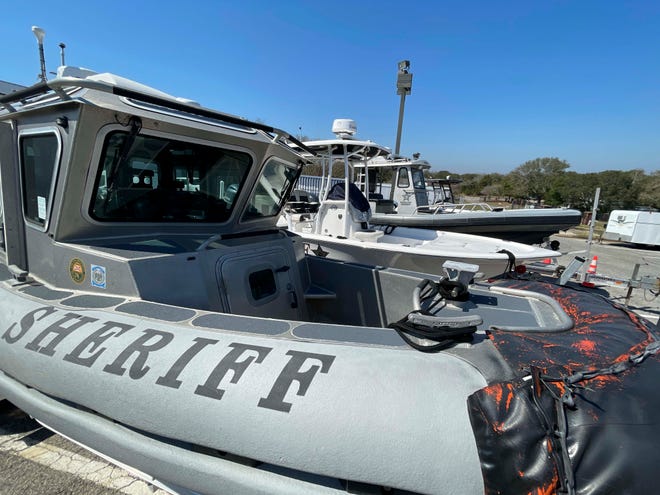
And here comes another …
“If you’re showing signs of impairment, we’d go into a boating-under-the-influence investigation.”
And by the way, same rules apply back at the ramp when you’re loading ’er up to trailer back to the garage (or side yard, if you don’t have an HOA).
“If we see someone coming off the boat back at the dock, and they’re impaired, yes, we’ll investigate,” Velez says.
Bottom line? Hate to say it, but you have to lean on common sense, and I know what you’re thinking: “My common sense can’t survive the cooler.”
Well, then, live by the words of Inspector Harry Callahan: “A man’s got to know his limitations.”
In other words, don’t pack too many beers and seltzers. Save your money for shrimp, fiddlers and maybe that flashy lure you just can’t live without.
Halifax/Indian River

When it comes to fish that are fun to fight but generally unworthy of the filet knife, the broad-chested jack is near the top of every saltwater angler’s list.
But, perhaps ironically, it’s the lady who seems underrated.
The sleek ladyfish leaps, she angrily pulls, she twists and turns and does everything possible to separate from your hook.
And you thought it was humbling when she simply refused to return your calls.
The ladyfish doesn’t go quietly to dry land. But once there, this sleek fighter can rest relatively easy, because she’ll soon be tossed back into her ‘hood.
Too many bones, not enough meat, and what meat is offered isn’t exactly the flaky and tasty fare our discerning consumers prefer.
But boy, what fun to catch. And what’s more, they’re really turned on this spring.
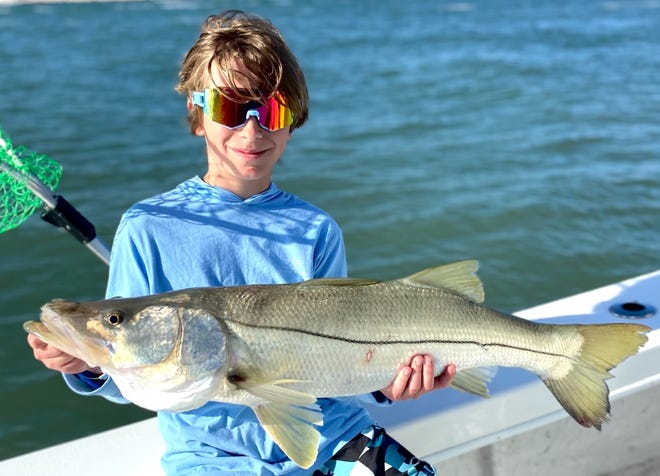
“All over the river between Daytona and the inlet,” says Capt. Jeff Patterson (Pole Dancer), who says jacks and bluefish — two other belligerents — are also plentiful these days.
“Several mornings, first thing, I’ve seen them busting baitfish right off the edge of the channel,” Capt. Jeff says. “It’s been a blast for kids, with tons of action to keep them busy.”
Our contributing fly-fisherman, Geno Giza, has headed home to Pennsylvania for the heated half of the calendar, but before he exited, his respect for ladyfish was raised a notch or three.
“Unfortunately, ladyfish may not get the respect deserved as a sought-after tackle buster,” Geno says. “But when fly-fishing, they’re the Cadillac of aerobatic stunt fish.”
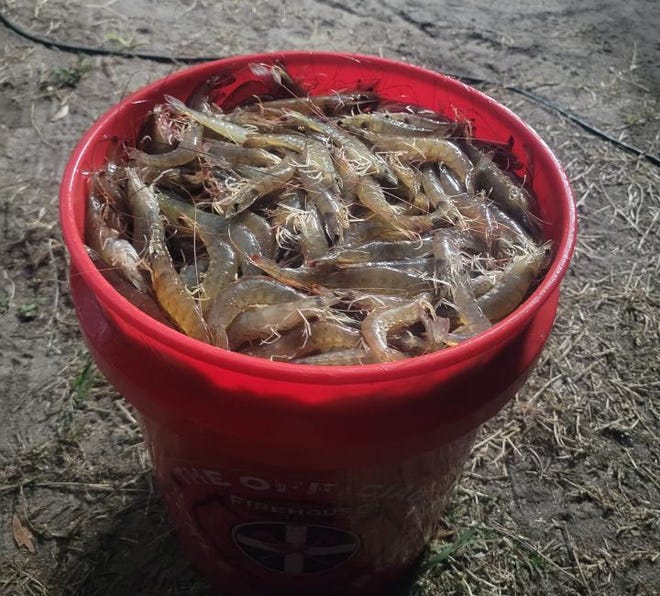
As for sea creatures that won’t put up a fight but will appeal to diners, the shrimp run recently started and continues to flow through Volusia County’s southeastern hot spot for the “poor man’s” favorite crustacean.
GJ Realin emailed a picture of his shrimp-filled bucket after a trip this past week.
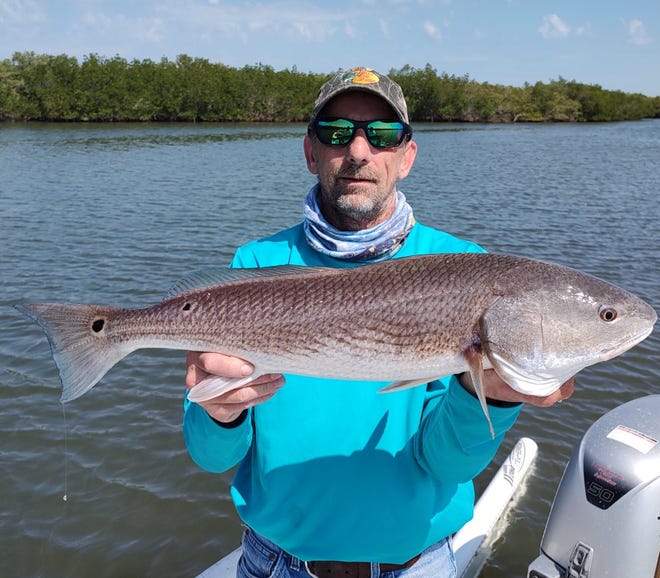
When employing the rod and reel instead of the net, he says, this week was slower than the previous few weeks, “despite plentiful mullet in all sizes.”
“The redfish bite was solid in the creeks south of Brown’s bay,” he adds.
Surf
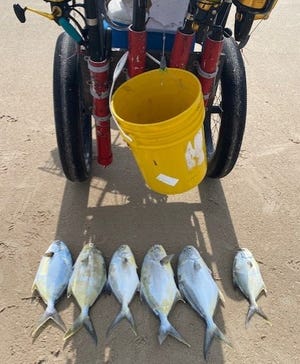
We’re hearing talk of sandfleas showing up in some bait shops. They’ve been scarce for roughly 18 months now, but first started coming to the surface in Flagler County and now to the south.
“Boy, they work,” says Marco Pompano, who spends big chunks of daylight hours surfside in the D.B. Shores, Wilbur and Ponce areas.
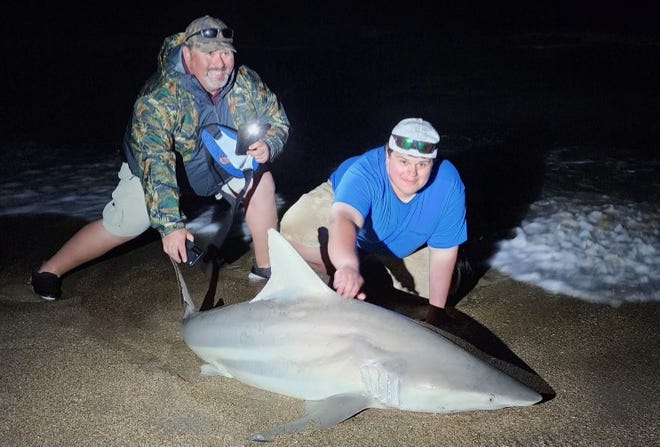
“A major load of pompano are still here and they’re bigger and stronger,” he says. “Me and my partners down here have been limiting out at six per day.”
Offshore
Big rays are cruising just offshore, and what does that mean?
If this were a crossword puzzle and you were looking at a five-letter word for that clue, it’d be c-o-b-i-a.
“Everybody and their brother has been out there trying to catch a cobia,” says Capt. Jeff Patterson, who often pushes out beyond the jetties with clients looking for bigger catches. “People are catching them.”
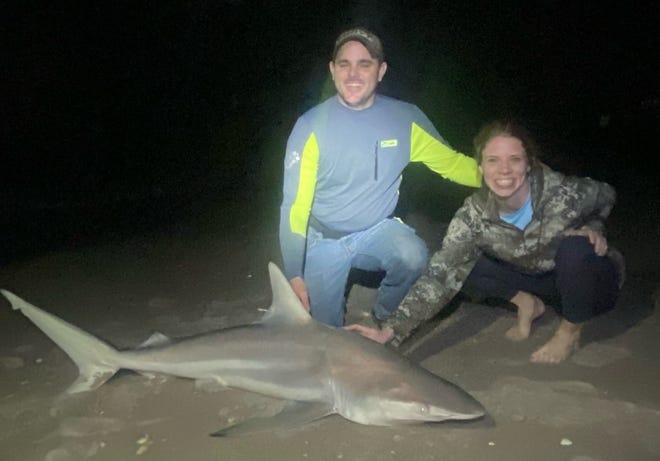
Too many people, some might say, but that’s another story.
“It’s been pretty crazy throughout the week,” Capt. Jeff says.
On the big-boat side, the Sea Spirit took advantage of improving conditions this week, and should be good through Saturday, before Sunday’s conditions take a rough turn.
Flagler
A few times a year, for whatever reason, the funky tripletail begins seriously sniffing around structure. And river buoys are considered structure — one of their favorites, actually.
“We’ve had reports of tripletails off the channel markers in the river,” says Capt. Mike Vickers (Hammock Beach Bait & Tackle). “Some in the 13-pound range.”
While sheepshead are still available near any piling wearing barnacles, the fishing-for-sport folks might want to start cracking their knuckles.
“Our first tarpon are being reported in the canals,” says Capt. Mike.
St. Johns

Speaking of never-fails seasonal events … if it’s April, it’s bluegill season on the St. Johns.
“Lots of bluegill and some shellcracker are being caught in the Norris Dead River,” says Capt. Bryn Adams (Highland Park in DeLand). “Live crickets, worms or even beetle-spins are the best baits, and casting up against the bank is the best method.”
Capt. Ray Cardona got into some striped bass this week, taking advantage of favorable breezes.
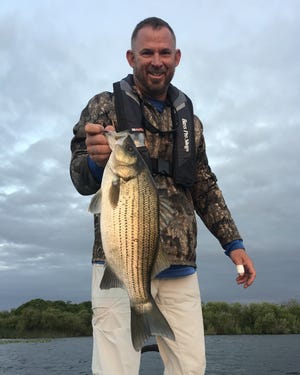
“It was blowing the baitfish up on the banks and was causing a feeding frenzy,” Capt. Ray says. “We caught most of our fish on topwater baits.”
Hook, line and clicker: Send us your fish pics
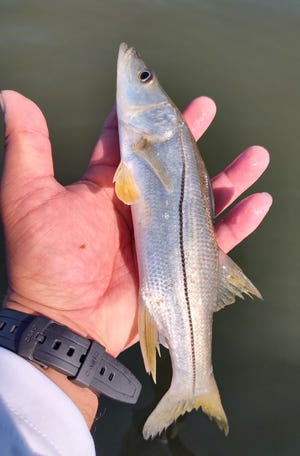
We want to see your most recent catch. Email your fish photos to [email protected].
Please include first and last name of angler(s), as well as type of fish (we’re occasionally stumped). All are included with our online fishing report, and some occasionally make the print edition.
Do I need a fishing license?
You can find all the license info, including exemptions, on Florida’s Fish and Wildlife Commission website: MyFWC.com. But the basics are: No: If you’re 65 or older, 15 or younger, you don’t need a license. No: If you’re fishing with a licensed guide or charter boat, both of which purchase commercial licenses that cover their customers. Yes: Most everyone else, including visitors from other states. Yes: Even if you’re a shore-based angler (shoreline, dock, pier, bridge, etc.). However: The shore-based license is free . . . But: You still need to register for that free license.
Where do I get a license and what does it cost?
Many bait shops sell licenses, as do the bigger retailers (Bass, Dick’s, Walmart, etc.). Florida’s FWC uses a third-party site for buying or renewing fishing licenses: GoOutdoorsFlorida.com. The cost: $17 for an annual license. Don’t forget: Whether you’re fishing fresh or saltwater, you need the specific license. Freshwater and saltwater licenses are both $17 annually.
I’m here on vacation, do I need a license?
Yes you do, and they’re also available at GoOutdoorsFlorida.com or certain bait shops and big retailers. Cost: $17 for three days, $30 for seven days, $47 for a year.Also: Non-residents need to purchase that license even if they’re just fishing from shoreline or shore-based structures. (Florida residents need that license, too, but they’re free.)